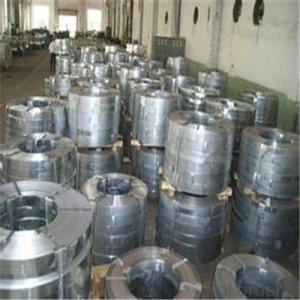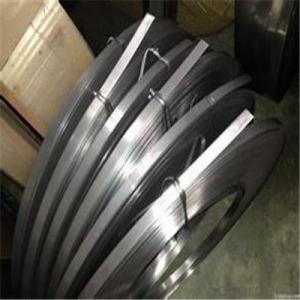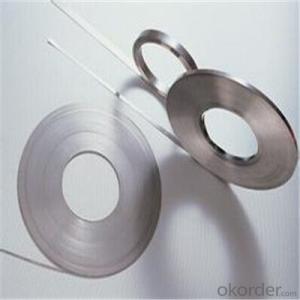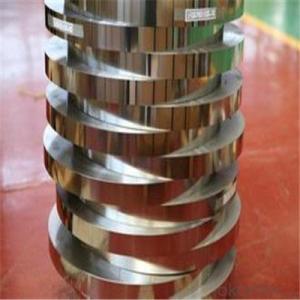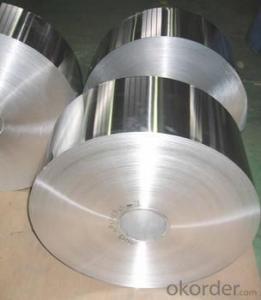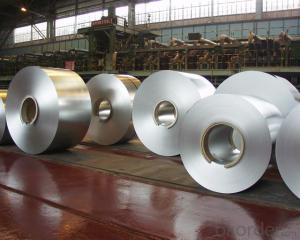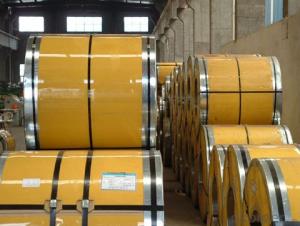Hot and Cold Rolled Steel Strip Coils Q195 Q235
- Loading Port:
- Shanghai
- Payment Terms:
- TT OR LC
- Min Order Qty:
- 50 m.t.
- Supply Capability:
- 122222 m.t./month
OKorder Service Pledge
OKorder Financial Service
You Might Also Like
Item specifice
Description of Steel Strip Coils:
Steel strips is one of our main products that is widely used in making band saw blade & other blades to cut paper, weed, etc.
Festures of Steel Strip Coils:
1. Each coil is closely covered by oil paper or plastic film.
2. Outside it is firmly packed with sack cloth or compound paper.
3. Steel strap or PP strap to pack the outside to ensure safety.
4. On/about 1000kgs to be packed with one wooden pallet.
5. Strips can be loaded to 20'FCL without pallet if required by customer.
6. LCL shipment can also be arranged once required by the customer.
Specifications of Steel Strip Coils:
| Description | Hot Rolled Steel Strip |
| Brand | Tianjin Metallurgical No.Steel Group |
| Specification | 1.2-6.0mm*70mm |
| Standard | AISI,ASTM,BS,DIN,GB,JIS |
| Material | Q195,Q215,Q215B,Q235,Q235B |
| Application | Widly used in welding steel pipes, and bicycle making etc. |
| Certificates | BV,SGS,ISO etc. |
| MOQ | 20 tons or according to customers’ requirement. |
| Port of Delivery | Tianjin Port of China |
| Remarks | We can provide qualify goods,competitive price and speedy delivery |
Images of Steel Strip Coils:
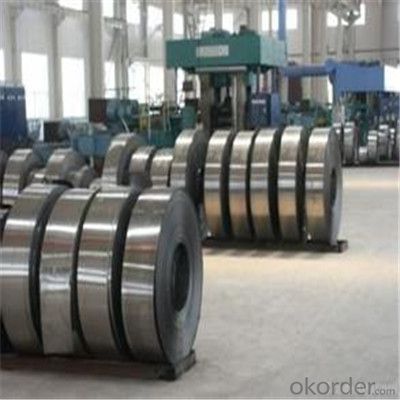
FAQ
1.What's your MOQ?
25MT, it is for one container.
2.Do you have QC teams?
Yeah, sure, our QC team is very important, they will keep the quality control for our products.
3. What's your normal delivery time?
Our delivery time about 10-20days for standard sizes, if you have other requirements like hardness and width ,it is about 20-40days.
- Q:How are steel strips processed for powder coating?
- Steel strips are processed for powder coating through a series of steps to ensure a high-quality and durable finish. The initial step involves cleaning the steel strips thoroughly to remove any dirt, grease, or contaminants that may be present on the surface. This is typically done using a chemical cleaning solution or a combination of water and detergent. Once the steel strips are clean, they are usually treated with a pre-treatment solution to enhance adhesion and corrosion resistance. This pre-treatment solution can vary depending on the specific requirements of the powder coating process, but it commonly involves the application of a conversion coating such as phosphating or chromate conversion. After the pre-treatment process, the steel strips are dried to remove any moisture or residual chemicals. This is typically achieved using ovens or heating chambers where the strips are subjected to controlled temperatures for a specific duration. Once dried, the steel strips are ready to be powder coated. Powder coating involves the application of a fine powder, typically made of thermosetting polymers, onto the surface of the strips. This is usually done using an electrostatic spray gun that charges the powder particles, causing them to adhere to the grounded steel surface. After the powder is applied, the steel strips are moved into a curing oven where the powder is melted and fused onto the surface. The curing process typically involves subjecting the strips to high temperatures for a specific duration, allowing the powder to flow and form a smooth, durable coating. Once the curing process is complete, the steel strips are cooled and inspected for quality assurance. This involves checking for any imperfections, such as uneven coating or defects, and making necessary adjustments or touch-ups if required. Overall, the process of processing steel strips for powder coating involves thorough cleaning, pre-treatment, drying, powder application, curing, and final inspection. This ensures that the steel strips are properly prepared and coated to provide excellent protection, aesthetics, and longevity.
- Q:How are steel strips used in the manufacturing of material handling equipment?
- Steel strips are commonly used in the manufacturing of material handling equipment for various purposes. One of the primary uses of steel strips is in the construction of frames and structures for these equipment. Steel strips provide high strength and durability, ensuring that the equipment can withstand heavy loads and operate efficiently in demanding environments. Steel strips are also used in the fabrication of components such as brackets, supports, and reinforcements. These components are crucial for the stability and functionality of material handling equipment. Steel strips can be easily shaped, cut, and welded, allowing manufacturers to create custom components that meet specific design requirements. In addition, steel strips are often used in the production of conveyor belts and chains for material handling equipment. These belts and chains are responsible for transporting goods, and steel strips provide the necessary strength and resistance to ensure smooth operation and long-lasting performance. Moreover, steel strips are utilized in the manufacturing of blades and cutting tools used in material handling equipment. These tools are essential for cutting, shearing, and shaping materials, and the strength and hardness of steel strips make them ideal for such applications. Overall, steel strips play a crucial role in the manufacturing of material handling equipment by providing strength, durability, and versatility. Their use in frames, components, conveyor belts, and cutting tools ensures that the equipment can handle heavy loads, withstand harsh conditions, and perform efficiently in various material handling operations.
- Q:What are the common heat treatment processes for steel strips?
- Steel strips can undergo various heat treatment processes, such as annealing, quenching, tempering, and hardening. Annealing entails heating the steel strip to a specific temperature and gradually cooling it down to alleviate internal stresses and enhance machinability. This process also boosts the steel's ductility and toughness, making it easier to shape and work with. Quenching, on the other hand, involves rapidly cooling the steel strip by immersing it in a quenching medium like oil or water. This swift cooling procedure strengthens the steel, rendering it more robust and resistant to wear. However, quenched steel can be brittle, necessitating further tempering. Tempering is a subsequent step to quenching that entails reheating the steel strip to a particular temperature and then cooling it at a controlled pace. This procedure diminishes the brittleness caused by quenching and enhances the steel's toughness and ductility. Tempering also helps relieve internal stresses and enhances the steel's resistance to fracturing. Hardening, similar to quenching, involves heating the steel strip to a high temperature and rapidly cooling it. This method heightens the steel's hardness and strength, making it suitable for applications that require exceptional wear resistance and durability. Each heat treatment process can be modified regarding temperature, cooling rate, and duration to achieve specific desired properties in the steel strip. The selection of a heat treatment process depends on the intended application and the desired mechanical and physical traits of the steel.
- Q:How do steel strips perform in welding and joining processes?
- Steel strips perform well in welding and joining processes due to their high tensile strength and excellent formability. They can be easily shaped and manipulated to fit the desired joint or welding configuration. Additionally, steel strips exhibit good heat conductivity, which aids in achieving strong and durable welds. Overall, steel strips are highly suitable for welding and joining applications and are widely used in various industries.
- Q:What are the advantages of using steel strips in construction?
- Using steel strips in construction has numerous advantages: 1. Strength and durability: Steel strips are exceptionally strong and durable, making them an ideal choice for construction. They provide structural integrity, can bear heavy loads, and withstand extreme weather conditions. 2. Versatility: Steel strips can be customized and molded to meet specific requirements, making them versatile for a variety of construction projects. They can be used for framing, roofing, flooring, and cladding, among other purposes. 3. Cost-effectiveness: While the initial cost of steel strips may be higher than other construction materials, they offer long-term cost savings. Steel is low-maintenance, resistant to corrosion, and has a long lifespan, reducing the need for frequent repairs and replacements. 4. Fire resistance: Steel is non-combustible and does not contribute to the spread of fire. This makes it a safer option for construction, particularly in buildings where fire safety is a priority. 5. Sustainability: Steel is an environmentally friendly material because it can be highly recycled. Steel strips can be recycled multiple times without losing their properties, reducing the demand for new materials and minimizing waste. 6. Speed of construction: Steel strips are pre-fabricated off-site, allowing for faster construction times. This can help reduce project timelines and costs, making them an attractive option for commercial and industrial construction projects. 7. Design flexibility: Steel strips offer flexibility in design, enabling architects and engineers to create unique and innovative structures. They can be easily combined with other construction materials to achieve desired aesthetics and functionality. In conclusion, the use of steel strips in construction offers advantages such as strength, durability, versatility, cost-effectiveness, fire resistance, sustainability, speed of construction, and design flexibility. These benefits make steel strips a popular choice for a wide range of construction projects.
- Q:What are the different methods for shearing steel strips?
- There are several different methods for shearing steel strips, depending on the specific requirements and desired results. Some of the most common methods include: 1. Guillotine shearing: This is one of the most traditional and widely used methods for shearing steel strips. It involves using a guillotine-style machine with a fixed blade and a moving blade that cuts through the steel strip in a straight line. 2. Rotary shearing: In this method, a rotary shear is used to cut the steel strip. The shear consists of a set of rotating blades that move in a circular motion to cut the strip. This method is often used for high-speed continuous cutting of steel strips. 3. Slitting: Slitting is a method used to cut wide steel strips into narrower ones. It involves passing the steel strip through a set of circular blades that move in opposite directions, creating parallel cuts and splitting the strip into multiple narrower strips. Slitting is commonly used in industries such as metal fabrication, automotive, and packaging. 4. Laser cutting: Laser cutting is a modern and highly precise method for shearing steel strips. It involves using a high-powered laser beam to melt or vaporize the material along a predetermined cutting line. Laser cutting offers a high level of accuracy, speed, and versatility, making it suitable for a wide range of applications. 5. Waterjet cutting: Waterjet cutting utilizes a high-pressure stream of water mixed with abrasive materials to cut through steel strips. The waterjet can be directed by computer-controlled mechanisms to follow a specific cutting pattern. This method is known for its ability to cut through various thicknesses and materials without generating heat or causing distortion. 6. Electrical discharge machining (EDM): EDM is a non-traditional machining process that can be used for shearing steel strips. It involves using electrical discharges to remove material from the workpiece. EDM can achieve precise and intricate cuts, making it suitable for cutting complex shapes and contours in steel strips. These are just a few of the different methods available for shearing steel strips. The choice of method depends on factors such as the required accuracy, speed, material thickness, and the specific application or industry in which the steel strips are used.
- Q:What are the environmental impacts of manufacturing steel strips?
- The manufacturing of steel strips has several environmental impacts. Firstly, it requires a significant amount of energy, often derived from fossil fuels, leading to greenhouse gas emissions and contributing to climate change. Additionally, the extraction of raw materials, such as iron ore and coal, can result in habitat destruction and biodiversity loss. Steel production can also generate air and water pollution through the release of pollutants and chemicals, impacting both human health and ecosystems. Lastly, the disposal of waste materials, including slag and dust, can pose environmental challenges if not managed properly. Overall, the manufacturing of steel strips has significant environmental consequences that need to be addressed through sustainable practices and technologies.
- Q:How are steel strips annealed for improved ductility?
- Steel strips are annealed for improved ductility by heating them to a specific temperature and then slowly cooling them. This process helps to relieve internal stresses and refine the microstructure of the steel, making it more flexible and less prone to cracking or breaking.
- Q:What are the main factors affecting the creep resistance of steel strips?
- The main factors affecting the creep resistance of steel strips are temperature, applied stress, and microstructure. Higher temperatures and higher levels of applied stress accelerate creep, while a finer and more uniform microstructure can improve creep resistance. Additionally, the presence of impurities and alloying elements can also influence the creep behavior of steel strips.
- Q:What are the different welding techniques for steel strips?
- There are several different welding techniques for steel strips, including but not limited to: 1. Arc welding: This involves using an electric arc to create intense heat that melts the steel strips, allowing them to fuse together. 2. Gas welding: In this technique, a flame produced by the combustion of a fuel gas, such as acetylene, is used to melt the edges of the steel strips, which are then pressed together to form a joint. 3. Resistance welding: This method utilizes the application of electric current and pressure to join the steel strips. It includes spot welding, seam welding, and projection welding. 4. Laser welding: This technique employs a high-energy laser beam to melt and fuse the steel strips together. It provides precise control and is often used for high-quality and automated welding applications. 5. Friction welding: This process involves rubbing the steel strips together at high speeds, generating heat due to friction, which ultimately results in a solid-state weld. 6. Ultrasonic welding: This method employs high-frequency vibrations to generate heat and bond the steel strips together. It is commonly used for small-scale and precision welding applications.
1. Manufacturer Overview |
|
|---|---|
| Location | |
| Year Established | |
| Annual Output Value | |
| Main Markets | |
| Company Certifications | |
2. Manufacturer Certificates |
|
|---|---|
| a) Certification Name | |
| Range | |
| Reference | |
| Validity Period | |
3. Manufacturer Capability |
|
|---|---|
| a)Trade Capacity | |
| Nearest Port | |
| Export Percentage | |
| No.of Employees in Trade Department | |
| Language Spoken: | |
| b)Factory Information | |
| Factory Size: | |
| No. of Production Lines | |
| Contract Manufacturing | |
| Product Price Range | |
Send your message to us
Hot and Cold Rolled Steel Strip Coils Q195 Q235
- Loading Port:
- Shanghai
- Payment Terms:
- TT OR LC
- Min Order Qty:
- 50 m.t.
- Supply Capability:
- 122222 m.t./month
OKorder Service Pledge
OKorder Financial Service
Similar products
New products
Hot products
Related keywords
